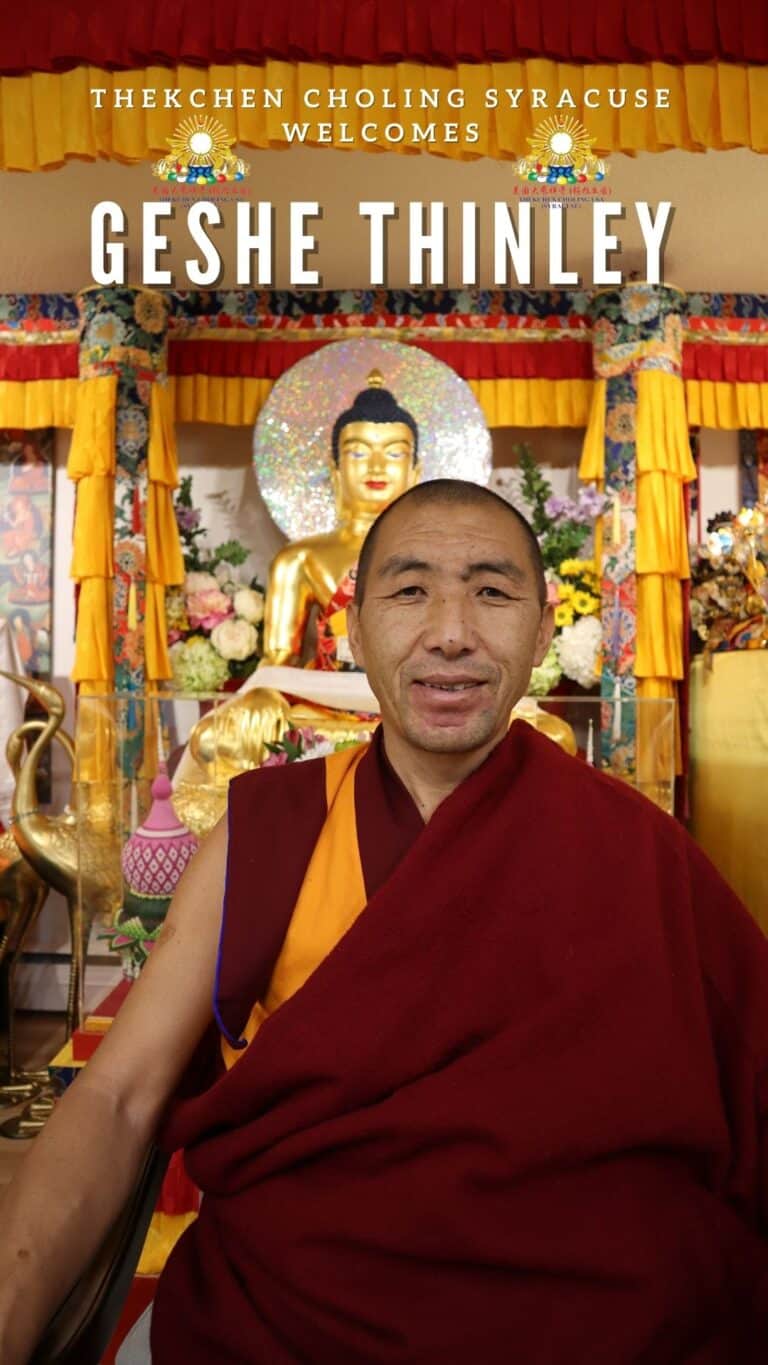Monk on a Mission
A conversation with Thekchen Choling Syracuse’s resident teacher.
If you’ve ever spent time at Thekchen Choling Syracuse, you’ve likely come across Geshe Lharampa Thinley Namgyal. “Geshe-La,” as he’s affectionately called, is the temple’s resident teacher. He’s also its secret weapon. “Few temples in our area have someone like him on staff,” says President Babette Teich-Visco. “Geshe-La is warm, caring and supportive. He’s also highly intelligent, like a walking encyclopedia.”
We recently caught up with Geshe-La, who’s halfway through a five-year residency in Syracuse. Shy and thoughtful, the Tibetan native is an attentive listener—more concerned with the heart of what’s being said than the words themselves. “Real listening happens in the spaces between the words,” he says smiling.
Did you always want to be a monk?
I grew up in a farming family in Tibet, the oldest of six children. Life was hard, and we worked a lot.
Whenever Buddhist monks came to our village, I noticed how happy and content they were. My mother was a big inspiration to me and supported my decision to become a monk at the age of 18.
Keep in mind that it was the Eighties, an interesting time in Tibet. The Chinese Cultural Revolution had just collapsed, so many Buddhist shrines and monasteries were reopening. I joined Sera Monastery near the capital city of Lhasa.
What is monastic life like?
It’s a big commitment—lots of sacrifice and self-discipline. For years, I spent 12-14 hours a day studying Buddhist philosophy and logic, reciting prayers, and debating scripture. At one point, I memorized about 800 pages of texts. Most of my studies were in Tibetan, but I also became fluent in English.
Where else did you study?
I spent five years at the monastery and then at the request of my teacher, visited Dharamsala [home of His Holiness the 14th Dalai Lama] in northern India. Like many other Tibetans, I hiked from Tibet to India through the Nepal Himalayas. It was a long, difficult journey.
I met my guru, Jhado Rinpoche, during a brief stay in Dharamsala in 1994. [Then a teacher at Namgyal Monastery in Dharamsala, Rinpoche later served as abbot from 1997-2007.] The first thing he encouraged me to do was join Sera Jey Monastery in southern India.

How long were you there for?
I spent 23 years at Sera Jey, studying epistemology [Parnama], discipline [Vinaya], the Perfection of Wisdom [Prajñāpāramitā], the Middle Way [Mādhyamika] and the Treasures of Knowledge [Abhidharmakosha]. I also memorized texts, debated, meditated and briefly served as the monastery’s master of discipline.
In 2017, I graduated with a Geshe Lharam, which is the highest Tibetan Buddhist degree available—the equivalent of a Ph.D. I briefly attended Upper Tantric College, also in India, before Rinpoche recommended me for the post in Syracuse. I taught for us online and then moved here in 2021.
What teachings do you resonate with most?
It’s important to learn, reflect and meditate on the two kinds of bodhicitta: Relative Bodhicitta and Ultimate Bodhicitta. [Relative Bodhicitta is how we learn to love others and ourselves. Ultimate Bodhicitta goes a step further, positing that the absolute nature of everything is emptiness.]
Bodhicitta is the most beautiful thing in the world. When cultivated in our moment-to-moment mind-stream, it can rid us of delusions—distorted thoughts and emotions that cause suffering. [The main types of delusion are ignorance, self-grasping and self-cherishing.] An awakened mind is a peaceful one because it realizes that everything lacks inherent existence.
Do you plan to stay in the United States for good?
Yes. The people in Syracuse are friendly and genuinely interested in Buddhism. I also love the scenery here. When the weather is nice, I ride my bike to Green Lakes [State Park] in Fayetteville.
The temple lets me live my dharma. When I’m not offering prayers and recitations, I teach and lead devotional practices, provide consultations for individuals and couples, and perform house blessings. I also pray and do rituals for people who are sick, dying or have died.
What text do you recommend for beginning Buddhists?
The Great Treatise on the Stages of the Path to Enlightenment, also known as Lamrin Chenmo. This classic text was written by Lama Tsongkhapa, a 15th-century monk who founded the Gelug school—the newest and largest school of Tibetan Buddhism.
His treatise outlines three principal aspects of Tibetan Buddhism: renunciation, bodhicitta and wisdom. These aspects form the quickest path to Buddhahood.
What advice do you have for fellow Buddhists?
Keep a good heart. Be compassionate. And work for the sake of others.

